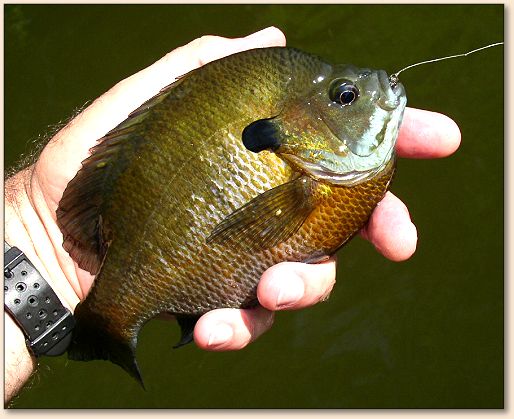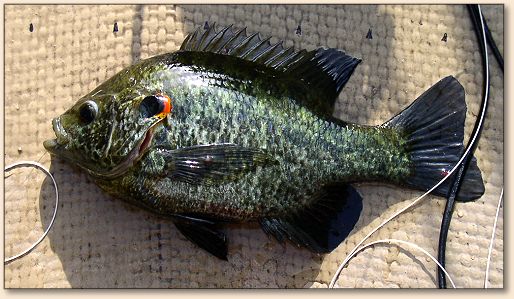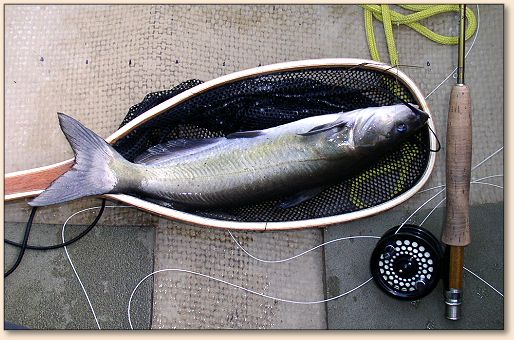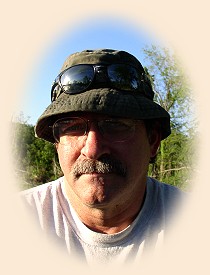|
I caught eight hefty bluegills so fast that I almost
reeled in and left Melvern Lake Pond to hunt for a
hilltop of sufficient elevation that my cell phone
signal would reach my buddy Donnie, 60 miles away
back in Lawrence. I wanted to give him a panfishing
situation report; he'd be interested in what had just
happened.
But dirty rat that I am, I let it go, opting to stay put
and keep casting to these hog 'gills until their
self-preservation instincts kicked in. Besides, Donnie
was busy housebreaking a new 8-week old puppy he'd just
bought, and who was I to interfere with the fun he was
having cleaning up puppy puddles and piles?
Still, who wouldn't want to put a bluegill report like
this one on the cell phone airwaves to a buddy? I mean,
there's bluegills and then there's BLUEGILLS. Anyone who
panfishes long enough eventually connects with old male
'gills whose trademark pumpkin-colored bellies are
non-evident; the bold orange hue has been crowded out by
the color black? The eight heavyweight dark-bodies I'd
just caught and released, bad boys like these during their
lifetimes have racked up more insect kills than an Ace
Hardware bug zapper.
It's important that I give due credit here. Catching
these fish from the spot I was standing would not have
happened if not for another angler, a spin fisherman,
who beat me to the rip-rapped face of a Corps of Engineers
interior park road bridge that crosses the old Marias des
Cygnes River channel at Melvern Lake Pond. He'd arrived
at the east end of this bridge minutes before me. After
walking down to the water at the west end to inspect the
place as a possible canoe put-in point, my peripheral vision
caught his arm moving in a pendulum motion. When I looked
over, he was giving the old heave-ho to a largemouth bass
that looked to be 15-inches, easy. Just a beautiful bass.
As the big fish's body arced high through the air, three
thoughts came to me: 1) that's an unnecessary and damn
disrespectful way to release a nice bass; 2) this guy might
know how to catch fish, and; 3) there are good-sized fish
at this bridge and maybe I can catch some!
I walked over to where he was, careful to stay up on the
road so's not to impart foot vibrations, and complimented
him on the nice bass he'd just caught. Then I asked if he
was planning to fish the entire length of the bridge's
rip-rap. If he was (pointing back at "my" west end of the
bridge) I told him of a submerged log there that slopes down
into the water. That log is a logical place for more good
bass to be holding, and if he wants to go over and try that
log then please do, because he got here first. I would hold
my horses until he fished this entire bridge, if he wanted
to do that. "Besides," I explained, "I'm here after bluegills,
not bass - and I've been told there's some really good 'gills
in here."
"You were told right," the man said, "See that bend where
the channel turns? There's a spot around there they really
like. And thanks, but I'll keep fishing this spot right here.
You go ahead and fish that other end; I'm just messin' around
waiting for a buddy to show up. Once he gets here we're gonna
put my little 2-seater on the Pond." This pleasant
conversation freed me up to work the west half of the bridge,
the idea of which had suddenly become exciting.
I'd come here today with no more interest in this bridge than
it offered a convenient spot to launch my canoe, after which
I would immediately paddle up the old Marias des Cygnes channel
to do some "recon panfishing." The thought had not occurred
to me to fish the water AT the bridge. In hindsight this was
pretty stupid of me given the incredible action I'd enjoyed
just two Fridays earlier in Iowa, where the 100+ crappie I
caught that day were holding tight against limestone rip-rap.
Well, no time for self-recrimination. This fellow throwing a
Rapala minnow to my east had just caught a 15-inch LMB here.
There could be some serious action to be enjoyed here, so I
better let the canoe fishing wait and get my butt in gear
right now.
I quickly rigged up, tippy-toed down the bridge footing's
grassy slope and "stepped up to the plate" at the extreme
west end of the bridge where the limestone rip-rap begins.
The submerged log referred to earlier laid to my right
slightly out of casting range - just the way I wanted it.
Anytime you must walk across rip-rap to reach a
favorable-looking fishing spot, my thinking is it's better
to approach the spot laterally with your feet at near-water
level rather than take the obvious shortcut of walking straight
down the rip-rapped slope. Call it a stealth issue because
it is, but it's also a safety issue. I've seen men take
terrible and painful falls when walking straight down
rip-rapped inclines; a rock they stepped onto appeared
stable but tipped once the man's full body weight suddenly
came to bear. It's safer and sneakier, I think, to slowly
zig-zag your way down to the water and once you're there
creep along laterally, gingerly testing each rock you step
on, using one foot to gradually add some of your weight but
not all of it at once before finally committing your entire
body weight (and your breakable bones) to the advance.
A 20-mph wind was zipping across the bridge from behind, and
it promised to mess with my backcast. If this wind wasn't
bad enough, there also was a speed limit sign and guard rail
directly behind me, too. Ordinarily the difficulties of this
wind and these obstacles would seem insurmountable, but doggone
it, that guy over at the east end had caught a 15-inch bass.
Old Reliable (#10 flashback Hare's Ear Nymph) dimpled the
water midway between the left riverbank and the submerged
log. I let him settle to good depth then began creeping
him in using a left-hand alternating pickup. Nothing.
"Okay, that's cool," I thought, "But just wait until I reach
that submerged log, Mr. Rapala-throwing Spinfisherman.
You're gonna see something you've seldom witnessed."
I was antsy to fish that submerged log, but before stepping
onto the rip-rap to approach it I threw my second cast into
a spot that hugs the left riverbank. It was just a short
3/4 sidearm flip of 20 feet that shot my nymph back
underneath a small tree's overhanging branches. Five feet
in, something dropped a bomb on Old Reliable. Lucky for
me the water at this bridge corner is obstacle-free, because
whatever took my nymph was all over the place before I finally
worked it high enough to ID a dark-sided, black-belly male
'gill of some 9 inches. As I hoisted the fish from the water,
I turned to give Mr. Spinfisherman a holler so I could show
him this excellent 'gill. I wanted to thank him for helping
me confirm the favorable recommendations I'd received about
this river channel some two months ago. But he'd left; there
he was walking down the road toward a row of fifth-wheeler
campers spotted along Melvern Pond's shore. I yelled anyway
but he didn't hear me in the wind.
After Old Reliable fooled six more hefty 'gills in the small
zone under that left bank tree, I eased over to the submerged
log. Needless to say, by now I was foaming at the mouth
anticipating the action I would enjoy there - and not just
on big bluegills but likely I would also connect with some
largemouth bass as well. But it was not to be. I caught
just one big 'gill at the log, and that was that. Ten
minutes followed with no more hits so I returned to my
original plan and launched the canoe to do some recon fishing.
Technically, this old river channel segment is a man-made
bayou. Not surprising, then, that the water in the near-bridge
zone is pretty deep. In a cut off channel like this, you don't
have much sediment building up from stormwater inflow. After
government purchase, most Corps-bought land rapidly becomes
thickly vegetated where farming operations are curtailed.
(Whereas prior to Melvern Lake's construction this whole
area was tilled farmland that contributed large amounts of
unsecured sediment to the channel following heavy rains.
Indeed, historical accounts I've read say that in what is
now Kansas not just the Marias des Cygnes but ALL of our
streams ran virtually clear year-round before European
settlers tilled the land and over-grazed the prairie.)
Consequently the water lying in this old channel segment
is thus clearer than the Marias des Cygnes River had been
immediately before lake construction. But so deep is the
channel now that the first half dozen times I anchored I
almost ran out of anchor line before my soft bags touched
bottom. Even areas close to the banks were quite deep.
This discouraged me because over the last two years of fly
rodding I've come to believe that panfish are primarily
shallow water dwellers - 6 ft. deep or less. I realize
this isn't the case under all circumstances, but it's
become my basic operational assumption anytime I go fishing.
After going hitless in some 200 at-bats in this deep water,
I paddled away from the bridge area. Up around the first bend,
on my left was an inside arc of the old river channel. On a
living river the inside arcs are where you almost always find
gentler bank slope angles, the shallowest water and the slowest
current speed. Maneuvering in to where my canoe was situated
midway between the left bank's weedline and a series of
rotting tree stumps standing 15 feet off the bank, I lowered
anchors and was encouraged to discover the depth here was only
about 3 feet. Off to my right some 80 feet away, at the outside
arc of the old channel lay, I knew the depth over there would be
much deeper - which meant I was anchored in shallow water that
would progressively deepen as my casts fanned to the right.
This place would do.
Out flew Old Reliable, landing midway between the rotting tree
stumps and the left bank. About halfway back to the boat he
got dry gulched by a strong fish that felt like a bluegill,
and that's what it was. Over the next 45 minutes I caught
and released maybe 20 big gills from this spot. The largest
were holding in a weedline pocket. Apparently these bluegills
had commandeered this inside arc for use as a nesting area,
and they were congregated making (or guarding) nests in depth
anywhere from one to five feet. The biggest and strongest of
these 'gills hammered Old Reliable when I dropped him an inch
away from an isolated standing weed, in water no more than a
foot deep.
If only we could photograph every fish we catch, wouldn't
that be nice? Of course, it isn't possible and attempting
it risks subjecting expensive cameras to water damage.
Nevertheless, I had a camera along and shot one photo of a
'gill that represents the average size of what I was catching
at this inside river arc.

When this spot played out I worked my way up-channel then back
down-channel without finding another bluegill hotspot. This
got me to thinking there could be a serious problem in this
bayou because of too much channel depth. So when I came upon
a tributary creek, I headed up it in hopes of finding shallower
water. After rounding an S-curve, I was so intent on looking
down into the water that I almost ran aground before realizing
the creek stops here.
At this moment a powerful swirl appeared 15 feet to my left,
next to a submerged limb. I quickly lowered my stern anchor
(to brake the canoe's forward motion) then the bow bag (to
nail the front of the canoe in place) and threw a cast into
the general area where the swirl appeared. Whatever made
that swirl approved of Old Reliable and grabbed him two
seconds after splashdown. This was a strong fish that
fought bitterly until the last. Surprise, surprise: a
red ear sunfish, a thick-bodied 10-incher that while being
measured fixed me in a cold stare, like I owed him money.

A few casts later came a hit from a fish even stronger yet.
Its rocket runs and bottom-hugging fight made me think
channel cat, freshwater drum or carp. Channel cat it was,
a 16-incher that fought so hard and so long that exasperation
finally made me reach down and pull in the leader barehanded
so I could net him and end the fight.

With water depth only 18-inches and wind-blown leaves and
grass stems snagging my fly for a piggyback ride almost
every cast, I retreated back down the creek channel to
deeper, open water next to a log that lays perpendicular
to the channel midline. Anchored here, throwing downstream
and working my nymph toward me slowly and deep, I hooked
something that in very leisurely fashion swam upstream
past my canoe then self-released before tasting the
mustard on the hotdog.
As it was approaching 8 p.m. now and I needed to find an
Eisenhower State Park campsite to spend the night, I left
this feeder creek and made my way back down the old Marias
des Cygnes channel to the put-in spot. I'd had good success
today, but felt I'd been more lucky than good. If not for
my chance meeting with Mr. Spinfisherman, odds are this
trip would have been a total bust. Without him I'd have
not have fished the bridge put-in spot, and after paddling
up the bayou I almost certainly would have gone right past
that first inside arc where the 'gills were.
Sure wish I could have thanked that guy, but after he
walked into the crowded campground I never saw him again.
~ Joe Hyde
About Joe:
 From Douglas County, Kansas, Joe is a former municipal and
federal police officer. In addition to fishing, he hunts
upland birds and waterfowl, and for the last 15 years
has pursued the sport of solo canoeing. On the nearby
Kansas River he has now logged nearly 5,000 river miles
while doing some 400 wilderness style canoe camping
trips. A musician/singer/songwriter as well, Joe's
'day job' is with the U.S. General Services Adminstration.
From Douglas County, Kansas, Joe is a former municipal and
federal police officer. In addition to fishing, he hunts
upland birds and waterfowl, and for the last 15 years
has pursued the sport of solo canoeing. On the nearby
Kansas River he has now logged nearly 5,000 river miles
while doing some 400 wilderness style canoe camping
trips. A musician/singer/songwriter as well, Joe's
'day job' is with the U.S. General Services Adminstration.
Joe at one time was a freelance photojournalist who wrote the
Sunday Outdoors column for his city newspaper. Outdoor
sports, writing and music have never earned him any money,
but remain priceless activities essential to surviving the
'day job.'
|




 From Douglas County, Kansas, Joe is a former municipal and
federal police officer. In addition to fishing, he hunts
upland birds and waterfowl, and for the last 15 years
has pursued the sport of solo canoeing. On the nearby
Kansas River he has now logged nearly 5,000 river miles
while doing some 400 wilderness style canoe camping
trips. A musician/singer/songwriter as well, Joe's
'day job' is with the U.S. General Services Adminstration.
From Douglas County, Kansas, Joe is a former municipal and
federal police officer. In addition to fishing, he hunts
upland birds and waterfowl, and for the last 15 years
has pursued the sport of solo canoeing. On the nearby
Kansas River he has now logged nearly 5,000 river miles
while doing some 400 wilderness style canoe camping
trips. A musician/singer/songwriter as well, Joe's
'day job' is with the U.S. General Services Adminstration.